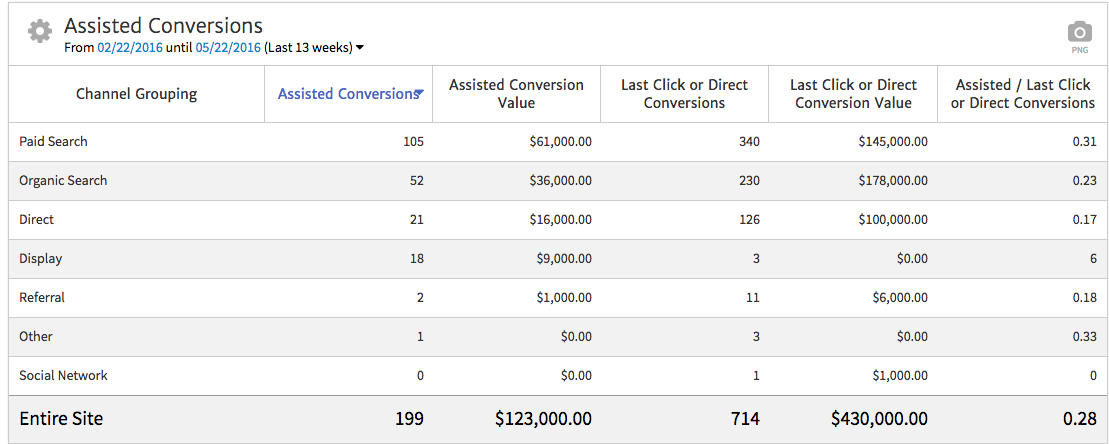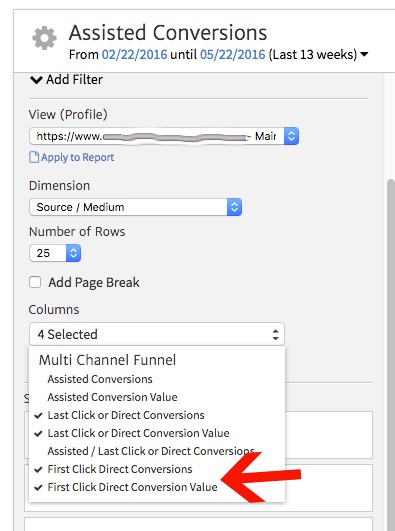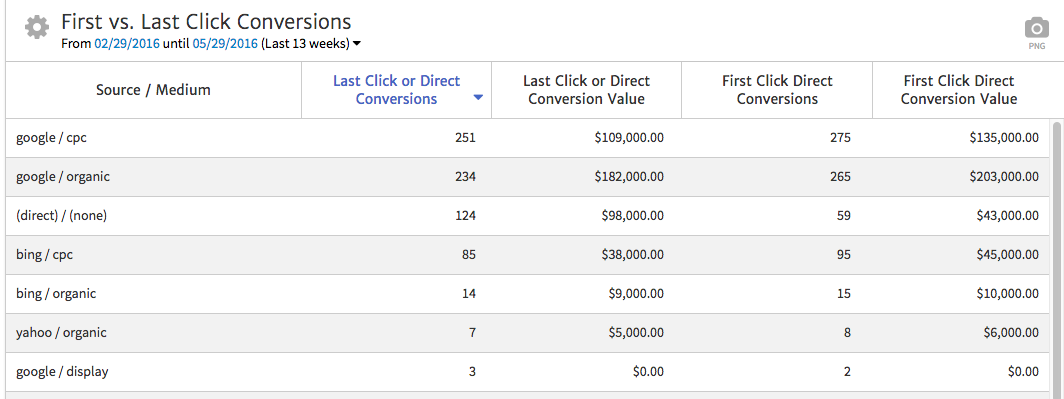May 21, 2024
Customizing Megalytic Using the Assisted Conversions Widget
By Megalytic Staff - June 13, 2016

Understanding Assisted Conversions
Conversions alone are a useful metric, but they are not always a complete picture. What if someone converted from a display ad but originally discovered the site via organic search? Looking at conversion alone, you’d never know that organic played an important role in that lead.
Assisted Conversions help to show the story of earlier stages in the lead funnel, when people may have had initial contact with the site before coming back to the site.
Looking at last-click conversions alone (attributing leads to the final source before the conversion), you’re likely not giving fair credit to digital marketing efforts that may be more successful than you think. In fact, when we looked at newsletter opt-ins for a popular blog, close to half came from returning users.
Sources at each stage of the funnel should be acknowledged for their value, from the initial discovery to sealing the deal with a form fill or purchase. Knowing that many converters come back to the site one, two, three, or more times after their initial contact, you’re missing out on opportunities to gauge success by not reporting Assisted Conversions to your clients. Assisted Conversions attribute conversions to channels when they were part of the conversion path but not the final source for the new lead.
To easily report on this data, Megalytic offers an Assisted Conversions widget that pulls in the data in a highly customizable format. Let’s dive into how to use this widget to improve how you report on conversion performance.
Customizing the Assisted Conversions Widget
When you first add this widget to your report, you’ll see a table breaking down channels, along with conversion performance and values for each. Note both Assisted Conversions and Last Click or Direct Conversions (the numbers you’d see in the main Conversions report) appearing in this example. Also, Conversion Value correlates to an average value per lead of $1,000 for this client.
Here, we can see that Assisted Conversions account foar a 31% increase above the last click conversions counted for paid search and a 23% increase for organic search. As most clients are highly influenced by ROI on campaigns, the corresponding value of leads emphasizes the need to report on these conversions. Looking at these numbers, in addition to what came from the last click, helps to demonstrate overall value.
Now, let’s look at how you can customize this widget to better show performance. Say you want to look at metrics more specifically than Channels, drilling into specific sources that drove conversion. For instance, you want to separate Bing and Google search.
Click the gear in the upper left of the widget to begin customizing it. Next, switch the Dimension dropdown to Source/Medium, which will break down the sources contributing to conversion.
Now, we can see paid search broken into google/cpc and bing/cpc, showing the performance of each search engine. If you want to show more than the default 10 sources, use the Number of Rows dropdown to choose a higher number.
Right off the bat, we can see that Google display advertising is much more likely to lead to Assisted Conversions than last click conversions. Users coming in from a display ad may later search for the brand to come back and convert. If there is any doubt over whether or not display is proving effective, this insight can help make the case.
Comparing First and Last Click
When evaluating conversions, consider the stages in the funnel that led a user to fill out a form or make a purchase. As we noted, Google Analytics, by default, attributes conversions to the last click. But what about the first click? This widget allows you to go beyond looking at assisted conversions as a whole to identify the first source that drove a user to the site before conversion. To set up this comparison, use the Columns dropdown in the Assisted Conversions widget to select First Click and Last Click Conversion metrics.
Apply these settings to your widget, and you’ll see totals for First and Last Click Conversion performance, along with the value tracked for each. As you can see, both organic and paid sources actually show a higher conversion volume in the First Click column than in the Last Click column. Based on this data, search serves as a vital point of discovery for the site, even if people don’t convert right away.
In addition, Direct traffic shows significantly higher conversion volume for Last Click, with almost twice as many as for First Click. This data demonstrates that many people discover the site through paid search or organic search first, before they later return directly to convert.
Explaining the Data
While Assisted Conversions are crucial to understanding the full funnel of a site’s lead performance, this type of data also becomes more complex to understand. For those less familiar with online marketing, the concepts beyond the basics of visits and leads can become confusing and difficult to grasp.
You may need to delve into the finer points of how analytics work and explain what Assisted Conversions are and why they matter. The fact is they tell a more complete story of how each source contributed to conversion beyond what you can see in the main Conversions section of Google Analytics. Ultimately, these matter to your client because they help to more accurately attribute how many leads came from each source. In addition, understanding how a particular source fits into the conversion path (First Click or Last Click Conversion) can help you make improvements to your site to help align messaging and Call to Actions (CTAS) with these behavior patterns.
Since this can get complicated you can use a Notes widget to explain metrics that clients may not immediately understand, while also addressing the implications of the data. For instance, even though they may not be being seeing many leads immediately attributable to organic search, assisted conversions may show that organic search contributes to more leads earlier on, driving users to the site who later return via another source. Make sure you take the time to process the insights the data provides to call out any value you can attribute to the marketing channels with which you work.
Conclusion
If you’ve been looking for a better way to tell the whole story of how sources drove leads for your clients, introduce the Assisted Conversions widget to your reports. Once you can break down conversions beyond those attributed to the last click, you can more accurately show how much true value each source provides. If you’re able to connect a dollar value to leads in your Analytics data, you can more thoroughly show ROI for each channel. In the digital marketing the glory shouldn’t be reserved for the guy who makes the shot. Assisted conversions let us know who our playmakers are so we can accurately assess what it takes to be champions.





